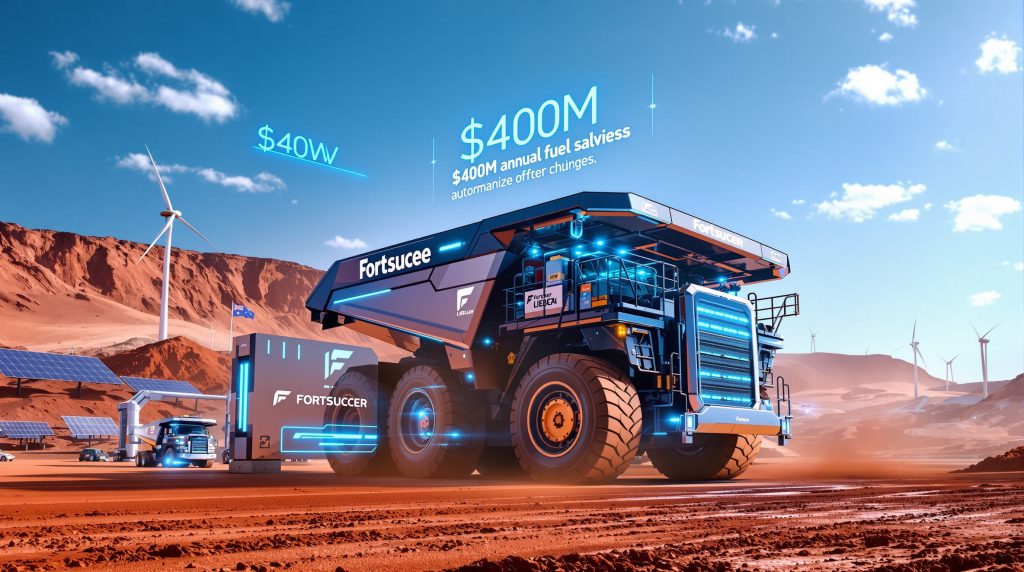How Are Electric Haul Trucks Transforming Fortescue's Mining Operations?
Electric haul trucks represent a revolutionary shift in Fortescue's mining operations, fundamentally transforming how materials are transported across their sites. The company has embarked on an ambitious decarbonization journey, systematically replacing diesel-powered equipment with zero-emission alternatives. This transition delivers benefits far beyond environmental impact, offering substantial operational advantages including reduced maintenance requirements, enhanced worker safety conditions, and dramatically lower operating costs.
The scale of this transformation is impressive, with potential annual fuel cost savings exceeding $400 million. Fortescue has ordered 360 electric haul trucks from Liebherr as part of a comprehensive $4 billion electrification initiative. This investment aligns with their aggressive decarbonization timeline, which aims to completely eliminate Scope 1 and 2 emissions by 2030.
"We're moving rapidly to decarbonize our Pilbara iron ore operations and eliminate our Scope 1 and 2 terrestrial emissions by 2030," stated Dino Otranto, Fortescue Metals Chief Executive Officer. "To achieve this target, we will need to swap out hundreds of pieces of diesel mining equipment at the end of their life with zero emissions alternatives."
Key Transformation Metrics
- Annual fuel cost savings: $300-400 million
- Electric haul truck order: 360 Liebherr T264 units
- Investment scale: Part of a $4 billion electrification initiative
- Decarbonization timeline: Complete elimination of Scope 1 and 2 terrestrial emissions by 2030
The transformation extends beyond just environmental benefits. Electric equipment has proven its operational capabilities, with battery-powered vehicles moving millions of tons of material at Fortescue mines over the past two years. This practical experience has validated the technology's reliability and effectiveness in demanding mining environments.
What Financial Benefits Do Electric Haul Trucks Provide Fortescue?
Dramatic Fuel Cost Reduction
The shift to electric haul trucks is generating extraordinary financial benefits for Fortescue, with fuel savings estimated between $300-400 million annually according to Gavin Mooney, General Manager at energy software platform Kaluza. These figures align with industry analyses from IDTechEx suggesting a single 150-tonne haul truck typically consumes approximately $850,000 in diesel fuel yearly.
"Fuel and energy costs are Fortescue's biggest operating costs as well as largest source of emissions. By electrifying operations like this it will be able to kill two birds with one stone," Mooney explained.
These savings represent a significant portion of Fortescue's operational expenses, demonstrating that sustainable technology adoption can deliver substantial bottom-line benefits alongside environmental improvements.
Maintenance Cost Advantages
Electric haul trucks feature significantly fewer moving parts than their diesel counterparts, resulting in:
- Reduced maintenance frequency requirements
- Lower parts replacement costs
- Decreased downtime for repairs
- Extended operational lifespan
The simplicity of electric drivetrains eliminates many common failure points in traditional diesel equipment, including complex transmissions, exhaust systems, and fuel delivery components. This mechanical simplification translates directly to maintenance cost reductions and improved equipment availability.
Total Cost of Ownership Improvements
When factoring regenerative braking capabilities in certain mining applications, electric haul trucks can recapture energy during downhill operations, further enhancing their economic advantage. In some cases with high amounts of regenerative braking, these vehicles can operate without significant recharging costs.
The combination of fuel savings, maintenance reductions, and energy recovery creates a compelling total cost of ownership case that justifies the initial capital investment. While electric equipment typically carries a higher upfront purchase price, the operational savings accumulate rapidly, particularly in fuel-intensive applications like mining industry innovation.
What Are the Technical Specifications of Fortescue's Electric Haul Trucks?
Liebherr T264 Battery-Electric Specifications
The cornerstone of Fortescue's electric fleet transformation is the Liebherr T264 battery-electric haul truck, an engineering marvel that combines massive hauling capacity with zero-emission operation:
| Specification | Details |
|---|---|
| Empty Weight | 176 tonnes (194 tons) |
| Payload Capacity | 240+ tonnes (265+ tons) |
| Battery Capacity | 3.2 MWh |
| Charging Time | Approximately 30 minutes |
| Charging Power | 6 MW DC fast charging |
These massive vehicles defy conventional notions of electric vehicle capabilities. The 3.2 MWh battery pack is over 40 times larger than typical passenger electric vehicle batteries, enabling these trucks to move hundreds of tons of material without producing any tailpipe emissions.
Revolutionary Charging Infrastructure
Fortescue's implementation includes proprietary 6 MW DC fast charging technology—a system delivering 6,000 kW of power, representing one of the most powerful charging solutions globally. To put this in perspective, this charging capacity could theoretically recharge a Tesla Model Y Long Range's 75 kWh battery in approximately 30 seconds (though standard passenger vehicles aren't designed to accept such power levels).
This ultra-high-power charging capability is crucial for maintaining operational efficiency, allowing the massive trucks to quickly recharge during natural operational breaks rather than requiring extended downtime.
Autonomous Capabilities
The electric haul truck deployment includes autonomous operation features, further enhancing operational efficiency by enabling:
- 24/7 operation with minimal human intervention
- Optimized routing and material movement
- Reduced human exposure to potentially hazardous environments
- Improved precision in loading and unloading operations
The combination of electrification and automation represents the cutting edge of electric mining transportation, creating synergies that maximize both environmental benefits and operational performance.
How Does Fortescue's Electric Fleet Strategy Support Its Sustainability Goals?
Comprehensive Decarbonization Approach
Fortescue's electric haul truck initiative forms part of a broader sustainable mining transformation that includes:
- Complete elimination of Scope 1 and 2 terrestrial emissions by 2030
- Replacement of hundreds of diesel equipment pieces with zero-emission alternatives
- Integration of renewable energy sources to power electric mining equipment
- Development of green hydrogen solutions for applications where battery-electric may not be optimal
"As the global mining industry continues to evolve, we're proud to be at the forefront of driving innovation in value adding green technology and showing the world that industry can decarbonize," Otranto stated, highlighting the company's leadership position in sustainable mining practices.
Environmental Impact Reduction
Beyond carbon emissions, the electric fleet transition delivers additional environmental benefits:
- Elimination of diesel particulate matter improving air quality at mining sites
- Reduced noise pollution in mining operations
- Decreased risk of fuel spills and contamination
- Lower overall ecological footprint of mining activities
These environmental improvements contribute to better relationships with local communities and strengthen the company's social license to operate in environmentally sensitive regions.
Worker Health and Safety Improvements
The shift to electric equipment creates healthier working conditions through:
- Elimination of diesel exhaust exposure for workers
- Reduced heat generation in underground mining applications
- Lower noise levels protecting worker hearing
- Decreased vibration reducing operator fatigue
These health and safety benefits align with Fortescue's commitment to worker wellbeing while simultaneously advancing operational and environmental goals.
What Equipment Beyond Haul Trucks Is Fortescue Electrifying?
Comprehensive Equipment Electrification
Fortescue's zero-emission strategy extends beyond haul trucks to include:
- Electric excavators that have already moved millions of tons of material
- Zero-emission drilling equipment
- Battery-powered support vehicles
- Electrified material processing equipment
This comprehensive approach ensures that emissions reductions occur across the entire mining operation, not just in material transportation.
Strategic Equipment Partnerships
To achieve its ambitious electrification goals, Fortescue has established partnerships with multiple equipment manufacturers:
- $4 billion agreement with Liebherr for electric haul trucks
- Over $400 million investment in Chinese equipment from XCMG
- Collaboration with various OEMs to develop custom zero-emission solutions
- Internal development through Fortescue Zero division
These strategic partnerships enable Fortescue to access the latest technology while supporting the development of the zero-emission mining equipment ecosystem globally.
How Does Fortescue's Approach Compare to Industry Competitors?
Mining Industry Electrification Leadership
Fortescue has positioned itself at the forefront of mining industry electrification, with several distinguishing factors:
- Scale of commitment (360 electric haul trucks ordered)
- Comprehensive approach across multiple equipment types
- Development of supporting infrastructure like 6 MW charging
- Clear timeline for complete decarbonization by 2030
This leadership position gives Fortescue first-mover advantages in operational efficiency and sustainability credentials.
Competitive Landscape
Other mining companies and equipment manufacturers are also advancing electrification efforts:
- Caterpillar has developed 240-ton electric haul trucks being tested at Vale mines
- Hyundai, Bobcat, and Volvo CE showcased electric mining equipment at CES 2024
- Various mining operators are conducting pilot programs with electric equipment
- Battery swap technologies are being explored by some manufacturers
While competition in this space is increasing, Fortescue's early and substantial commitment to electrification has established the company as an industry leader in sustainable mining practices.
What Implementation Challenges Is Fortescue Addressing?
Infrastructure Development
Deploying hundreds of electric haul trucks requires substantial supporting infrastructure:
- Installation of 6 MW charging stations throughout mining operations
- Grid upgrades to support increased electricity demand
- Integration of renewable energy generation to power charging systems
- Development of maintenance facilities specialized for electric equipment
Fortescue is addressing these challenges through careful planning and phased implementation, ensuring that infrastructure development keeps pace with equipment deployment.
Operational Transition Management
Shifting from diesel to electric equipment involves significant operational adjustments:
- Retraining maintenance personnel for electric systems
- Developing new operational procedures for charging management
- Optimizing routes and schedules around charging requirements
- Implementing software systems to manage the electric fleet efficiently
The company is investing in comprehensive training programs to ensure that personnel at all levels are prepared for the transition to electric equipment.
Technology Maturation
As an early adopter of large-scale electric mining equipment, Fortescue is addressing:
- Battery performance optimization in extreme mining conditions
- Durability testing of electric components in harsh environments
- Software development for autonomous electric equipment
- Integration of electric vehicles with existing fleet management systems
By working closely with equipment manufacturers, Fortescue is helping to accelerate the maturation of electric mining technology through real-world implementation and feedback.
What Future Developments Are Expected in Fortescue's Electric Fleet?
Expansion of Electric Equipment Deployment
Fortescue's current electric haul truck orders represent just the beginning of a comprehensive transformation:
- Continued replacement of diesel equipment as it reaches end-of-life
- Expansion of electric technology to additional equipment categories
- Integration of lessons learned from initial deployments into future purchases
- Potential development of next-generation electric mining equipment
This ongoing deployment will progressively reduce emissions while increasing operational efficiency across the company's mining operations.
Technology Advancement
Ongoing improvements in electric mining technology will likely include:
- Increased battery energy density extending operational range
- Enhanced fast-charging capabilities reducing downtime
- Advanced autonomous features optimizing electric equipment utilization
- Improved durability and reliability in mining environments
Fortescue's large-scale deployment provides valuable data and experience that will inform these technological advancements.
Potential Hydrogen Integration
While battery-electric solutions form the core of current efforts, Fortescue is also exploring:
- Hydrogen fuel cell applications for certain mining equipment
- Hybrid power systems combining batteries and hydrogen
- Green hydrogen production facilities to support fuel cell equipment
- Complementary zero-emission technologies for comprehensive decarbonization
This multi-technology approach ensures that Fortescue can select the optimal zero-emission solution for each specific application within their mining operations.
How Can Other Mining Companies Learn From Fortescue's Electric Transition?
Scalable Implementation Model
Fortescue's approach provides a blueprint for other mining operations considering electrification:
- Phased replacement of diesel equipment at end-of-life
- Strategic partnerships with equipment manufacturers
- Development of supporting charging infrastructure
- Integration with renewable energy generation
This model can be adapted to different scales and types of mining operations, making it relevant for companies of various sizes.
Economic Case Study
The documented fuel savings of $300-400 million annually demonstrates:
- Clear return on investment potential for electric mining equipment
- Importance of considering total cost of ownership beyond purchase price
- Financial benefits of early adoption despite higher initial capital costs
- Long-term economic advantages of decarbonization initiatives
These economic benefits make a compelling case for other mining companies to follow Fortescue's lead in electrification.
Technical Knowledge Transfer
Fortescue's experience with large-scale electric equipment deployment offers valuable insights on:
- Charging infrastructure requirements and design
- Battery performance in mining applications
- Maintenance needs of electric mining equipment
- Integration of electric vehicles into existing operations
By sharing these insights through industry forums and partnerships, Fortescue can help accelerate the adoption of data-driven operations and modern mine planning across the industry.
FAQs About Fortescue's Electric Haul Trucks
How long can Fortescue's electric haul trucks operate between charges?
While specific operational duration varies based on load, terrain, and conditions, the 3.2 MWh battery capacity is designed to support typical mining shift operations with strategic charging periods. The 30-minute fast charging capability enables quick power replenishment during operational breaks.
Will electric haul trucks perform as effectively as diesel models?
Electric haul trucks offer several performance advantages over diesel models, including better torque characteristics, more precise control, and improved reliability due to fewer mechanical components. The 240+ tonne payload capacity matches or exceeds comparable diesel models.
How is Fortescue powering its electric charging infrastructure?
Fortescue is developing integrated renewable energy solutions to power its charging infrastructure, aligning with its goal of eliminating Scope 1 and 2 emissions. This includes investments in solar, wind, and potentially green hydrogen production.
What happens to the diesel equipment being replaced?
As diesel equipment reaches end-of-life, it is being systematically replaced with zero-emission alternatives. This phased approach allows for orderly transition while maximizing the value of existing assets.
How does regenerative braking benefit mining operations?
In mining applications with significant elevation changes, regenerative braking allows electric haul trucks to capture energy during downhill transport, converting kinetic energy back into stored electrical energy. This can substantially reduce overall energy consumption and extend operational range.
Looking for the Next Mining Innovation to Invest In?
Discover breakthrough mining innovations like Fortescue's transformative electric haul trucks through Discovery Alert's proprietary Discovery IQ model, which provides real-time notifications on significant ASX mineral and technology discoveries. Visit our discoveries page to understand how major mining innovations can lead to exceptional investment returns.




